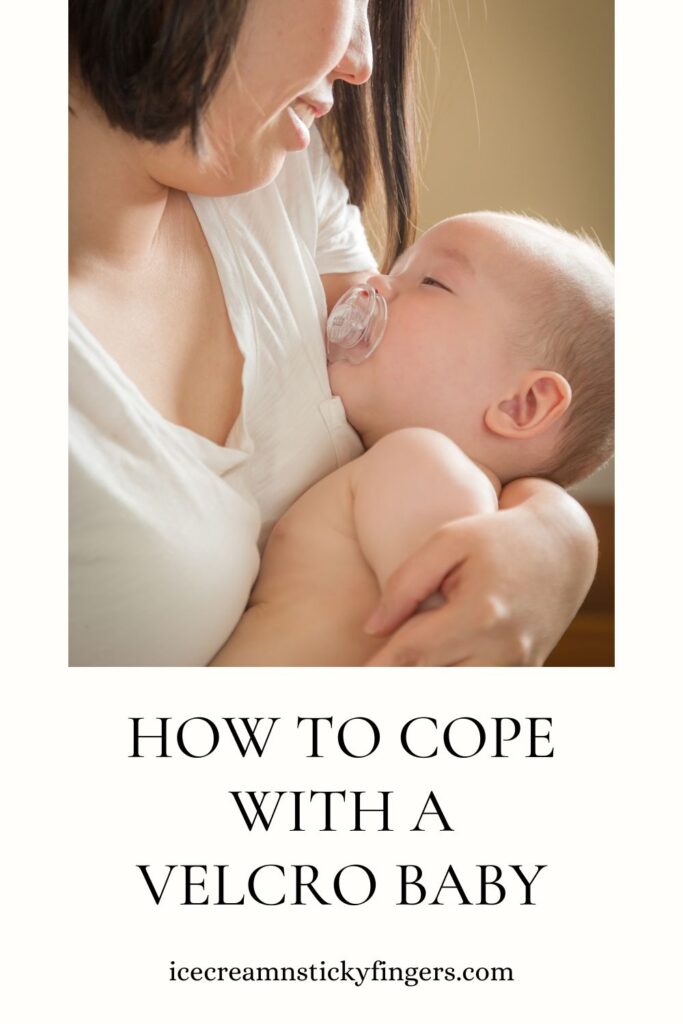Do you have a baby who constantly wants to be held or around their caregiver? Learn how to cope with a Velcro baby. My oldest son was a Velcro baby and I used to call him a touchy-feely baby because he wanted to be touching me constantly. As a parent, dealing with a baby that is constantly wanting to be held or near you can be quite challenging and overwhelming at times. Here are some strategies on how to cope with a Velcro baby:

Understanding Your Baby’s Needs
- Recognize the Behavior: Understand that it’s normal for some babies to need extra closeness and reassurance, especially in the first few months. But it can be tough to deal with especially if you are a stay-at-home mom or single parent. A velcro baby can make it hard to accomplish tasks. I have some strategies to help below to help you regain your routine.
- Attachment: Know that responding to your baby’s needs helps build a secure attachment, which is beneficial in the long run. An attached baby tends to trust their caregivers, they will discrimate against certain caregivers (baby tends to prefer one caregiver), get separation anxiety when removed from the primary caregiver, and possibly develop stranger anxiety.
Strategies for Coping
Here are some strategies for coping with your velcro baby. Using these strategies can help you maintain your sanity and get things done around the house.
- Babywearing: Use a baby carrier or sling to keep your baby close while freeing up your hands to do other tasks. This will allow you to be able to get some chores done without holding or putting your baby down.
- Create a Routine: Establish a predictable routine for feeding, sleeping, and playing to help your baby feel secure. A set routine will help get your child on a predictable schedule and help you have some free time or get things done around the house.
- Engage in Floor Time: Spend time on the floor with your baby, encouraging them to explore while still being close to you. A newborn baby needs plenty of tummy time too.
- Gradual Independence: Gradually encourage independence by slowly increasing the time your baby spends in a safe place like a playpen or crib, starting with short periods and extending as they get more comfortable.
- Comfort Objects: Introduce a comfort object, like a blanket or stuffed animal, that can provide reassurance when you need to step away. Just make sure that a blanket or stuffed animal isn’t going to be a potential hazard to your baby. No blankets in the crib until they are at least a year old according to the American Academy of Pediatrics.
- Tag-Team Parenting: If possible, share the caregiving responsibilities with a partner or trusted family member to give yourself a break. Remember as a caregiver you need time for self-care too.
- Set Up Safe Spaces: Create safe and engaging areas where your baby can be placed for short periods while you take care of other tasks. I suggest you use a swing (aff link), a bouncer (aff link), a playpen (aff link), or even their crib.
- Responsive But Not Overbearing: Respond to your baby’s cries and needs, but try to differentiate between different types of cries to avoid picking them up at every sound.
- Self-Care: Remember to take care of yourself. Rest when your baby naps and seek support from friends or family.
- Engage in Activities: Sing, talk, and play with your baby to keep them engaged and make them feel secure.

Emotional Support
A Velcro baby can be emotionally draining as well. So you need to seek help emotionally.
- Seek Support Groups: Join parenting groups where you can share experiences and get advice from others who have been through similar situations.
- Talk to a Professional: If you’re feeling overwhelmed, consider speaking with a pediatrician or a child development specialist for advice and reassurance.
Remember, this phase won’t last forever. As your baby grows and becomes more independent, they will naturally need less constant physical contact. But I get it, I had a Velcro baby and it was overwhelming. I used these techniques above and wanted to share with you how to cope with a Velcro baby.








My daughter was a velcro baby. She’d only sleep if someone was holding her for the first 4 months of her life. That was fun. Great advice!
I think it’s important to set up a routine that works for you as soon as possible. This can help with a needy baby
I love how you’ve shared practical tips for managing a Velcro baby while also reminding me to take care of myself. Your advice about babywearing and creating a routine really resonates with me, and I appreciate the focus on building a secure attachment while maintaining balance. Thank you!
These are good suggestions to consider when handling a velcro baby! Sometimes their need to be near endeared itself to me every time I’d remember that there will be a time, sooner than I’d think, that they won’t want to be near me much at all. Self care is essential though!
My kids were very fussy and clingy. I remember being at my wit’s end when it came to being a burned out mom.
Such helpful advice for dealing with a clingy baby! I love the practical tips for managing and easing separation anxiety.